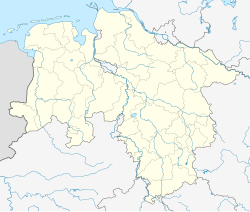Barsinghausen | |
|---|---|
 Barsinghausen Monastery | |
Location of Barsinghausen within Hanover district  | |
| Coordinates: 52°18′0″N9°28′52″E / 52.30000°N 9.48111°E | |
| Country | Germany |
| State | Lower Saxony |
| District | Hanover |
| Subdivisions | 18 district |
| Government | |
| • Mayor (2020–25) | Henning Schünhof [1] (SPD) |
| Area | |
• Total | 102.65 km2 (39.63 sq mi) |
| Elevation | 142 m (466 ft) |
| Population (2022-12-31) [2] | |
• Total | 35,156 |
| • Density | 340/km2 (890/sq mi) |
| Time zone | UTC+01:00 (CET) |
| • Summer (DST) | UTC+02:00 (CEST) |
| Postal codes | 30890 |
| Dialling codes | 05105 |
| Vehicle registration | H |
| Website | www.barsinghausen.de |
Barsinghausen (German pronunciation: [ˌbaʁzɪŋˈhaʊ̯zn̩] ⓘ ) is a town in the district of Hanover, in Lower Saxony, Germany. It is situated at the Deister chain of hills approx. 20 km west of Hanover. Barsinghausen belongs to the historic landscape Calenberg Land and was first mentioned in 1193.
Contents
- Geography
- Neighbouring places
- Division of the town
- History
- Population development
- Sights
- Education
- Elementary schools
- Secondary schools
- Special schools
- Twin towns – sister cities
- Notable people
- Associated with the town
- References
- External links






